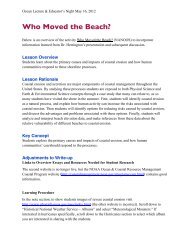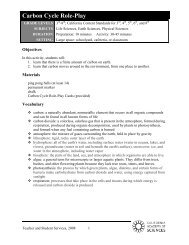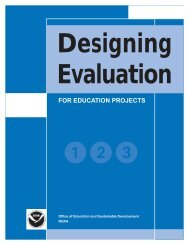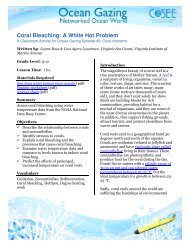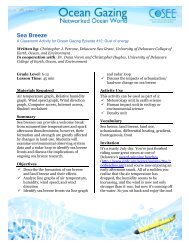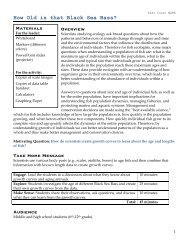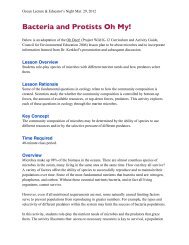Merit Review Broader Impacts Criterion: Representative Activities ...
Merit Review Broader Impacts Criterion: Representative Activities ...
Merit Review Broader Impacts Criterion: Representative Activities ...
Create successful ePaper yourself
Turn your PDF publications into a flip-book with our unique Google optimized e-Paper software.
<strong>Merit</strong> <strong>Review</strong> <strong>Broader</strong> <strong>Impacts</strong> <strong>Criterion</strong>: <strong>Representative</strong> <strong>Activities</strong><br />
Proposals submitted to the National Science Foundation are evaluated through use of<br />
two merit review criteria, which all proposals must address explicitly. Experience shows<br />
that while most proposers have little difficulty responding to the criterion relating to<br />
intellectual merit, many proposers have difficulty understanding how to frame the<br />
broader impacts of the activities they propose to undertake.<br />
The examples provided below are organized by the set of potential considerations used in<br />
assessing the broader impacts of the proposed activity. They illustrate activities that,<br />
when successfully incorporated in a project description, will help reviewers and NSF<br />
program staff address the broader impacts criterion in the review and decision process.<br />
The list is not intended to be exhaustive, nor is any particular example relevant to all<br />
proposals. Proposers can draw from the examples but are urged to be creative in their<br />
approaches to demonstrating the broader impacts of their projects. Proposers already<br />
undertaking similar kinds of activities should carefully consider how to link these<br />
examples to the research and education projects they are proposing for funding.<br />
Proposers also should consider what types of activities best suit their interests, while<br />
enhancing the broader impacts of the project being proposed.<br />
The components of the broader impacts criterion as defined by the National Science<br />
Board are listed below. The list is followed by short sections on each component that<br />
provide background information and representative activities.<br />
<strong>Broader</strong> <strong>Impacts</strong> <strong>Criterion</strong>: What are the broader impacts of the proposed activity?<br />
• How well does the activity advance discovery and understanding while promoting<br />
teaching, training and learning?<br />
• How well does the proposed activity broaden the participation of<br />
underrepresented groups (e.g., gender, ethnicity, disability, geographic, etc.)?<br />
• To what extent will it enhance the infrastructure for research and education, such<br />
as facilities, instrumentation, networks and partnerships?<br />
• Will the results be disseminated broadly to enhance scientific and technological<br />
understanding?<br />
• What may be the benefits of the proposed activity to society?
Advance Discovery and Understanding While Promoting Teaching, Training<br />
and Learning<br />
Background:<br />
Integration of research and education is one of "three core strategies that guide [NSF]<br />
in establishing priorities, identifying opportunities, and designing new programs and<br />
activities.... Effective integration of research and education at all levels infuses<br />
learning with the excitement of discovery and assures that the findings and methods<br />
of research are quickly and effectively communicated in a broader context and to a<br />
larger audience" (NSF GPRA Strategic Plan 2001 - 2006)<br />
Examples of <strong>Activities</strong>:<br />
• Integrate research activities into the teaching of science, math and engineering at<br />
all educational levels (e.g., K-12, undergraduate science majors, non-science<br />
majors, and graduate students).<br />
• Include students (e.g., K-12, undergraduate science majors, non-science majors,<br />
and /or graduate students) as participants in the proposed activities as appropriate.<br />
• Participate in the recruitment, training, and/or professional development of K-12<br />
science and math teachers.<br />
• Develop research-based educational materials or contribute to databases useful in<br />
teaching (e.g., K-16 digital library).<br />
• Partner with researchers and educators to develop effective means of<br />
incorporating research into learning and education.<br />
• Encourage student participation at meetings and activities of professional<br />
societies.<br />
• Establish special mentoring programs for high school students, undergraduates,<br />
graduate students, and technicians conducting research.<br />
• Involve graduate and post-doctoral researchers in undergraduate teaching<br />
activities.<br />
• Develop, adopt, adapt or disseminate effective models and pedagogic approaches<br />
to science, mathematics and engineering teaching.<br />
Broaden Participation of Underrepresented Groups<br />
Background:<br />
One of NSF’s five-year strategies is to "broaden participation and enhance diversity<br />
in NSF programs. At present, several groups, including underrepresented minorities,<br />
women, certain types of academic institutions, and some geographic areas are less<br />
than full participants in the science and engineering enterprise. NSF is committed to<br />
leading the way to an enterprise that fully captures the strength of America’s<br />
diversity." (NSF GPRA Strategic Plan 2001-2006)<br />
2
Examples of <strong>Activities</strong>:<br />
• Establish research and education collaborations with students and/or faculty who<br />
are members of underrepresented groups.<br />
• Include students from underrepresented groups as participants in the proposed<br />
research and education activities.<br />
• Establish research and education collaborations with students and faculty from<br />
non-Ph.D.-granting institutions and those serving underrepresented groups.<br />
• Make campus visits and presentations at institutions that serve underrepresented<br />
groups.<br />
• Establish research and education collaborations with faculty and students at<br />
community colleges, colleges for women, undergraduate institutions, and<br />
EPSCoR institutions.<br />
• Mentor early-career scientists and engineers from underrepresented groups who<br />
are submitting NSF proposals.<br />
• Participate in developing new approaches (e.g., use of information technology and<br />
connectivity) to engage underserved individuals, groups, and communities in<br />
science and engineering.<br />
• Participate in conferences, workshops and field activities where diversity is a<br />
priority.<br />
Enhance Infrastructure for Research and Education<br />
Background:<br />
The NSF Act of 1950 authorizes and directs the Foundation "to foster and support the<br />
development and use of computer and other scientific and engineering methods and<br />
technologies, primarily for research and education in the sciences and engineering;...”<br />
“NSF investments provide state-of-the-art tools for research and education, such as<br />
instrumentation and equipment, multi-user facilities, ... telescopes, research vessels<br />
and aircraft, ... Internet-based and distributed user facilities, ... research networks,<br />
digital libraries and large databases." (NSF GPRA Strategic Plan 2001-2006)<br />
Examples of <strong>Activities</strong>:<br />
• Identify and establish collaborations between disciplines and institutions, among<br />
the U.S. academic institutions, industry and government and with international<br />
partners.<br />
• Stimulate and support the development and dissemination of next-generation<br />
instrumentation, multi-user facilities, and other shared research and education<br />
platforms.<br />
• Maintain, operate and modernize shared research and education infrastructure,<br />
including facilities and science and technology centers and engineering research<br />
centers.<br />
3
• Upgrade the computation and computing infrastructure, including advanced<br />
computing resources and new types of information tools (e.g., large databases,<br />
networks and associated systems, and digital libraries).<br />
• Develop activities that ensure that multi-user facilities are sites of research and<br />
mentoring for large numbers of science and engineering students.<br />
Broad Dissemination to Enhance Scientific and Technological Understanding<br />
Background:<br />
"NSF advocates and encourages open scientific communication. NSF expects<br />
significant findings from supported research and educational activities to be promptly<br />
submitted for publication.... It expects PIs to share with other researchers, at no more<br />
than incremental cost and within a reasonable time, the data, samples, physical<br />
collections and other supporting materials created or gathered in the course of the<br />
work. It also encourages grantees to share software and inventions . . . and otherwise<br />
to make the innovations ... widely useful and usable." (GPG; NSF 01-2a)<br />
Examples of <strong>Activities</strong>:<br />
• Partner with museums, nature centers, science centers, and similar institutions to<br />
develop exhibits in science, math, and engineering.<br />
• Involve the public or industry, where possible, in research and education<br />
activities.<br />
• Give science and engineering presentations to the broader community (e.g., at<br />
museums and libraries, on radio shows, and in other such venues.).<br />
• Make data available in a timely manner by means of databases, digital libraries, or<br />
other venues such as CD-ROMs.<br />
• Publish in diverse media (e.g., non-technical literature, and websites, CD-ROMs,<br />
press kits) to reach broad audiences.<br />
• Present research and education results in formats useful to policy-makers,<br />
members of Congress, industry, and broad audiences.<br />
• Participate in multi- and interdisciplinary conferences, workshops, and research<br />
activities.<br />
• Integrate research with education activities in order to communicate in a broader<br />
context.<br />
Benefits to Society<br />
Background:<br />
NSF is committed to fostering connections between discoveries and their use in<br />
service to society. The knowledge provided by NSF-funded projects offers a rich<br />
foundation for its broad and useful application. For example, projects may contribute<br />
to understanding the environment, commercial technology, public policy, health or<br />
4
safety and other aspects of the public welfare. (NSF GPRA Strategic Plan 2001-<br />
2006)<br />
Examples of <strong>Activities</strong>:<br />
• Demonstrate the linkage between discovery and societal benefit by providing<br />
specific examples and explanations regarding the potential application of research<br />
and education results.<br />
• Partner with academic scientists, staff at federal agencies and with the private<br />
sector on both technological and scientific projects to integrate research into<br />
broader programs and activities of national interest.<br />
• Analyze, interpret, and synthesize research and education results in formats<br />
understandable and useful for non-scientists.<br />
• Provide information for policy formulation by Federal, State or local agencies.<br />
5




